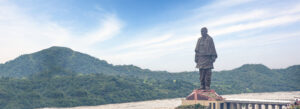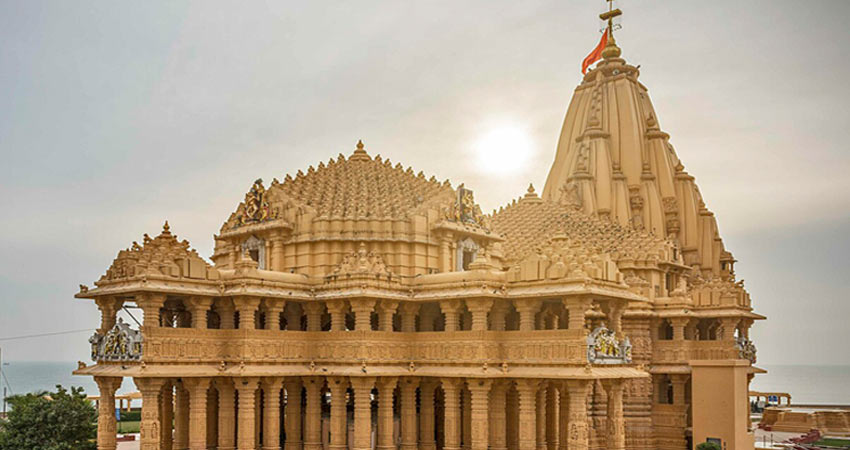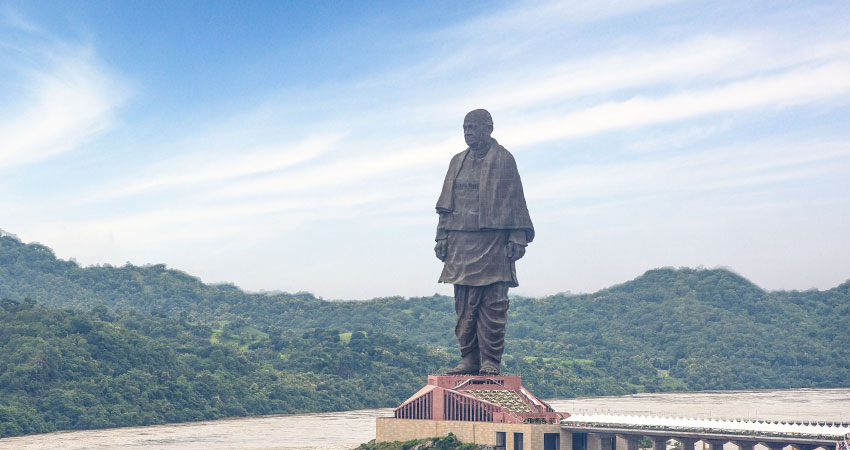- 15
- 3
- 2
- 9
- 12
- 2
- 1
- 9
- 1
- 7
- 12
- 3
Statue of Unity
Brief History
The Statue of Unity, built as an ode to the Iron Man of India, Sardar Vallabhbhai Patel, commemorates his role as the first Home Minister of independent India. He was instrumental in uniting 562 princely states to form the Republic of India.
About the Place
On October 31, 2018, the world’s tallest statue, the Statue of Unity, was inaugurated against the dramatic backdrop of the Satpura and Vindhyachal hills in Kevadia, Gujarat. The 182-meter (approximately 600 feet) statue is dedicated to Sardar Vallabhbhai Patel, the architect of independent India. Towering over the River Narmada, this colossal monument is a tribute from the people of Gujarat to a leader who prioritized public welfare. The statue overlooks the expansive river basin of the Narmada River and the sprawling Sardar Sarovar Dam. It stands on the Sadhu Bet hillock, connected by a 300-meter bridge, providing access from the mainland to the statue.
Construction and Outreach
As part of an outreach program, the state government asked Indian farmers to donate used farming equipment to collect iron for the statue. Approximately 5,000 tonnes of iron were collected. The construction details and the history of Sardar Patel can be explored in an in-house museum inside the statue.
Key Attractions
- Laser Light and Sound Show: A nightly light and sound show using laser technology is projected on the Statue of Unity, except on Mondays. The show, narrated by Amitabh Bachchan, provides a vivid account of Sardar Patel’s life, his contribution to the independence movement, and the unification of India.
- Valley of Flowers: Spread across 24 acres along the bank of the Narmada River, the Valley of Flowers is a vibrant garden with over 2.2 million plants. It features various ornamental flowers, trees, shrubs, herbs, climbers, and creepers. Numerous photo booths and selfie points enhance visitors’ experiences.
- Sardar Sarovar Dam: Standing at 163 meters, the Sardar Sarovar Dam is India’s third highest concrete dam and ranks second in the world in terms of volume for gravity dams, with 6.82 million cubic meters of concrete.
- Nauka Vihar: Boating in Panchmuli Lake offers tourists a serene 45-minute ride through lush green forests, providing a unique eco-tourism experience.
- Cactus Garden: This unique botanical garden showcases a vast variety of cacti and succulents, simulating a desert ecosystem within an aquatic environment. It houses 6 lakh plants of 450 species across 25 acres.
- Ekta Nursery: Developed to promote unity through nature, Ekta Nursery aims for visitors to take home seedlings as a memento. The nursery houses one million plants, with 0.3 million ready for sale.
- Children Nutrition Park: Inspired by Prime Minister Narendra Modi, this theme park educates children on healthy eating habits and nutritional values through engaging, technology-driven experiences.
- Dino Trail: Featuring a replica of the Rajasaurus Narmadensis, a dinosaur species endemic to the Narmada Valley during the Cretaceous period, the Dino Trail offers insights into the region’s ancient fauna.
- Jungle Safari: This zoological park features indigenous and exotic animals and birds from various biogeographic regions, offering an adventurous and scenic wildlife experience.
- Vishwa Van: Representing flora from all seven continents, Vishwa Van symbolizes global unity in biodiversity, showcasing the life-sustaining essence of forests.
Best Time to Visit
The Statue of Unity is best visited during the cooler months from October to February. The site is open year-round, from 8:00 AM to 6:00 PM, Tuesday to Sunday. The laser light and sound show begins at 7:30 PM daily, except on Mondays when the statue is closed for maintenance.

Shopping and Dining
- Ekta Mall: This 35,000 square feet mall promotes Indian handicrafts and textiles, featuring 20 emporia representing different states of India.
- SOU Souvenir Shop: Visitors can buy mementos like caps, t-shirts, and key chains to remember their visit.
- Ekta Food Court and SOU Food Court: These food courts, built to international standards, offer a variety of Indian and international cuisines.
- Amul Cafe: Located near the bus shuttle parking, this cafe provides a selection of dairy products.
Tourists can book tickets on the official website Statue of Unity or purchase them directly at the site. The online ticket booking is managed by the Sardar Vallabhbhai Patel Rashtriya Ekta Trust.


